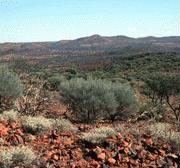
Planetary scale changes in the redox state of the Paleoproterozoic
atmosphere and hydrosphere have profoundly affected the evolution of life on
Earth. The accumulation of oxygen in the atmosphere is the result of
oxygenic photosynthesis, which is thought to have evolved prior to 2.7 Ga.
The Paleoproterozoic carbon cycle has experienced dramatic variations with
world-wide carbonate occurrences that recorded excursions of isotopically
heavy carbon, consistent with the oxygenation of the atmosphere. The
nitrogen cycle also appears to have evolved from the anoxic Archean
atmosphere, where biological nitrogen fixation was dominant, to the
oxygenated Proterozoic and Phanerozoic terrestrial surface where
denitrification became dominant. The oxygenation of the atmosphere can be
traced with multiple sulfur isotopes, which are known to fractionate
independently from their masses during the ultraviolet photolysis of reduced
or oxidized sulfur gases. Mass independently fractionated (MIF) sulfur
isotopes often occur in Archean sedimentary sulfides and sulfates, but very
rarely in rocks younger than 2.0 Ga. This observation is consistent with
the transition from an anoxic Archean atmosphere devoid of an ozone layer to
an oxygenated atmosphere more similar to the modern atmosphere. New
multiple sulfur isotopic analyses (32S, 33S, and 34S) of sulfides by
multicollector secondary ion mass spectrometry confirm that the MIF signal
is lost during the Paleoproterozoic. Variations in the sulfur isotopic
composition of Paleoproterozoic sulfides (d34S) may indicate periods of
higher or lower seawater sulfate concentration and may help to understand
the biogeochemical changes induced by the accumulation of atmospheric
oxygen.
 A Record of the Earliest (4.5-3.8 Ga) Surface Conditions on Earth?
A Record of the Earliest (4.5-3.8 Ga) Surface Conditions on Earth? Simulating Groundwater Radiolysis With Oxidation of Pyrite by Hydrogen Peroxide Solution
Simulating Groundwater Radiolysis With Oxidation of Pyrite by Hydrogen Peroxide Solution Exploring Planet-Forming and Debris Disks
Exploring Planet-Forming and Debris Disks Quantifying Water Production in Comets - The "Meter Stick" for Their Chemical Taxonomy
Quantifying Water Production in Comets - The "Meter Stick" for Their Chemical Taxonomy